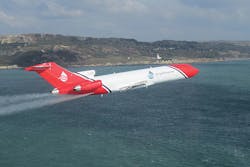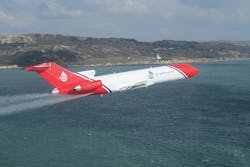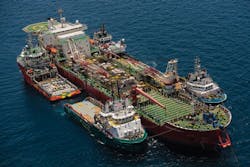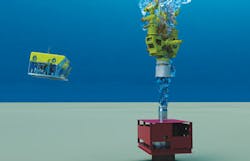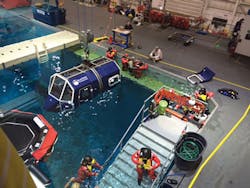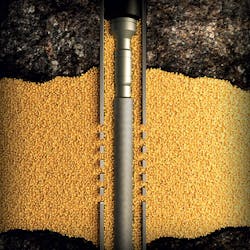New tools and technology for the offshore industry
Converted jet aircraft transforms spill response capability
Jeremy Beckman
Editor, Europe
Two former FedEx cargo aircraft have been converted for new roles in front-line oil spill combat. Both are also the first in the offshore sector to comply with recent changes to design standards for dispersant spray systems.
Owner Oil Spill Response Ltd. (OSRL), based in Southampton, UK is the leading industry-funded co-operative providing preparedness, response, and countermeasures to oil spills worldwide. Following mergers over the past decade with counterpart organizations East Asia Response Limited and Clean Caribbean & Americas, the association now has 42 full and over 100 associate members that include all the majors and most NOCs.
Since 2009 OSRL has helped contain all the significant offshore oil spills or leaks at Montara, Macondo, Bonga and Rayong, spraying dispersants from a four-engine turbo-prop L-382 Hercules. This is an aircraft best known as a cargo, medevac or troop carrier, according to Rob James, OSRL’s regional director for EMEA (Europe, Middle East and Africa), and the association has deployed two Hercules, one based in the UK and the other in Singapore. However, the magnitude of Macondo in 2010 caused the members to reassess their priorities for oil spill response, with calls for more capable and faster aircraft able to reach a developing incident more quickly.
“Another issue was the increasing cost of operating the Hercules,” James said. “This had become an old aerial dispersant platform, very thirsty for fuel, and with various aviation directives emerging that would have entailed substantial upgrades. Buying a newer version of the Hercules would also have been very expensive.”
OSRL appointed UK aero-engineering firm T2 Aviation to source, design, certify and operate the desired capability. T2 identified the two Boeing 727-2S2F (RE) freight aircraft - both delivered to FedEx in 1984, and the last ever produced - as providing the best combination of stability (especially for activating dispersants at low speeds), adaptability, and power-to-weight ratio. Both aircraft started out with Pratt & Whitney JT8D-9/15 engines, but these were later replaced with more efficient JT8D-217C engines located at the rear and centrally mounted as part of the Valsan program.
Simulator trials at a specialist Boeing facility in Miami confirmed that the aircraft were very attractive in terms of handling at low level, James said, while the engines’ high bypass ratio design provided a 6-7% reduction in fuel consumption compared to the Hercules. Because of their age the capital cost of the two aircraft was relatively low, while their metal frames would be easier and less costly to adapt than a more modern aircraft made of composite materials.
Following the commitment to purchase in May 2012, all upgrades to the two 727s were performed in the UK, mostly at ATC Lasham near Basingstoke, with much of the equipment manufactured in Peterborough, close to a cluster of specialist stainless steel component suppliers. The following year, James said, “we thought we were there, we had performed the first flight test. Then in early 2014, the UK’s Civil Aviation Authority [CAA] made a ruling, underpinned by the European Aviation Safety Agency [EASA], that totally changed what we had to do, obliging us to treat our dispersants as flammable liquids.
“Dispersants transported as cargo are non-hazardous, with IATA regulations establishing a flashpoint of above 60°C [140°F],” James explained. “We didn’t see these as flammable, and they hadn’t been on the Hercules. But the ruling was made, so effectively we had to start again from scratch in 2014 to design and build a system that would comply with the new regulations. It turned out to be an incredibly labor-intensive project both for OSRL and our contractors, and the CAA told us only Boeing or Airbus would normally undertake a project of this size.”
James continued: “You have to look at what would happen if the aircraft crashed: a survivable crash for the crew would be an acceleration of up to 9G, and you have to demonstrate that the system will stay intact at 9G, as you wouldn’t want the pilot to survive and then burn to death. This means that all the dispersant tanks have to be double-skinned, and everything has to be vented outside the aircraft, with no risk of introducing sparks or ignition sources - if there is a lightning strike on a vent, you must ensure that this won’t run to the tanks, and that means all the equipment, including the pumping systems, must be intrinsically safe, with no risk of introducing sparks or ignition sources.”
The Tersus system developed by T2 for the two jet aircraft features seven tanks that hold 15,000 liters of dispersant. The pump systems, housed on pallets, can be controlled from the cockpit: they are pre-armed and re-circulate the fluid so that spraying from the boom toward the rear of the aircraft can start immediately on its approach to the oil spill. Typically, spraying is performed at an altitude of 150 ft (45.7m) and a speed of around 150 kt (this compares with 130 ft (39.6 m) and 120 kt for the Hercules).
As with the Hercules, the 727s will not operate in bad weather, James said, both to safeguard the crew and because in high winds, dispersants end up missing their targets. One major operational improvement provided by the new system, compared to the Hercules, is the more accurate recording procedure. “Both 727s are equipped with onboard tracking,” he explained, “with a GPS connected to the pumps. This shows how much of the target area has been sprayed and when. ”
The CAA and the EASA have approved the final-draft system specification and the US Federal Aviation Administration (FAA) has also reviewed the documents. Both the FAA and EASA have since adopted the same certification standards for future large dispersant aircraft. Earlier this year the first remodeled aircraft demonstrated its low-flying dispersant capability in trials witnessed by OSRL members, successfully praying water over a target area just off the southern English coast.
Both aircraft will be based at Doncaster in northern England, with a pool of trained pilots to draw on at short notice to fly anywhere, or to ferry the 727 to its destination. One of the two Hercules will also remain on contract, based in Singapore.
Modified heavy-lift system facilitates rapid completion of decommissioning project
Peter Devine
Versabar
Versabar’s VB‐10K heavy-lift system has been deployed several times to the Gulf of Mexico, where it has removed more than 70,000 tons of decommissioned structures since 2010. A recent decommissioning project proved to be one of the company’s most challenging to date, and also served to highlight aspects of the innovative engineering.
The VB‐10K’s ability to reduce offshore exposure by performing single‐piece decommissioning is highly valued by offshore operators, and in 2014 Versabar secured a contract for the removal of a field of four production topsides with an aggregate weight of nearly 5,000 tons. The smallest was a 190 ton four‐pile, and was removed by the VB‐10K in its conventional fashion, using wire rope slings and shackles to hook to pad‐eyes on the structure, lift it off its jacket, and deposit it on a materials barge for transport to a shore-based salvage facility.
The initial plan was for the other three much larger topsides to be removed in a similar fashion, but there was one significant complication. The installation of pad‐eyes would require the cutting and removal of numerous sections of piping around the upper legs and the truss rows. Due to the nature of the reservoir, this piping contained significant levels of heavy metal contaminants. The cost associated with the prepping of the topsides, exposure to personnel, and mitigation of environmental issues associated with the contaminants was significant.
Therefore, the development of an alternative lift method was proposed that would safeguard the environment while reducing the client’s offshore exposure and cost.
Unable to affix pad‐eyes to the upper structure of the topsides, and committed to minimizing topsides preparation, Versabar engineers determined that the legs of the topsides represented structural hardpoints which could be used to perform the lifts. The question then became how best to adapt the VB‐10K’s versatile rigging applications to a leg‐based lift.
The solution was the Claw. Built in 2011, it was engineered primarily as a subsea lifting device which uses curved arms equipped with tines to slide beneath and cradle loads that are considered too badly racked or damaged to be lifted by conventional methods. For this project, Versabar engineers performed an important modification, installing spacer pipes in the Claw’s upper rigging that increased the span between the arms by 40 ft to provide adequate clearance to encircle the 100-ft wide topsides and reach the legs underneath. The next step was to find a way for the Claw arms to connect with the legs in order to lift the load in a safe and level fashion.
Given the wide array of lift packages handled by the VB 10K, in 2015 engineers had designed and fabricated a pair of 175‐ft‐long box girders which featured multiple pin holes and slots to provide a number of lift point options. After removing the tines from the Claw, engineers used adapter plates to pin these girders to the Claw arms and provide the span needed to interface with the legs of the topsides. Plate hooks were then welded to the girders in accordance with the spacing requirements of the legs - four hooks on each girder for the two eight‐pile topsides, three hooks for the six‐pile.
As this work was going on, Versabar field staff were busy offshore with the platform‐based preparations, which were comparatively straightforward: 16 ft beneath the cellar deck, welders cut one‐foot‐wide by four‐foot‐high slots into each leg. Through the slots on a longitudinal axis, 16-in. pins were installed. The lift would be achieved by guiding the plate hooks on the girders into the slots on the legs and raising the Claw arms to engage the pins. Remote cameras were installed on the beams to assist VB 10K operators in guiding the pins into the slots.
As with all Versabar offshore projects, the next step was systems integrated testing, or SIT. At its berth in Sabine Pass, Claw arms and girders were installed and a water‐filled barge was situated under the VB‐10K’s twin gantries. The rigging assembly was then lowered into position to engage the hooks with pins that had been welded onto the barges, and a 2,100‐ton test lift was performed. With the rigging load tested and all components working smoothly, the VB‐10K was ready to depart.
The VB‐10K arrived on site in the early hours of July 10, dropped its towline and entered the field. Using the system’s eight 1,000‐hp thrusters, operators initiated procedures for the first of the three topsides to be removed. As the lift system approached, welders on the structure removed clips holding the precut legs. Once the welding crew disembarked, the lift system maneuvered into position over the topsides.
Due to the presence of quarters buildings, helidecks, and flare booms, clearances on all three topsides were tight, but the VB‐10K’s DP-3 system assured a precise and steady line of approach. When the VB‐10K was centered above the first topsides, the Claw was lowered to bring the beam with its hooks in line with the legs.
Using the remote cameras and positioning stand‐by vessels and tugboats to act as spotters, VB‐10K operators now began the process of aligning the 6-in. beam hooks with the leg slots. Within 45 minutes, all eight hooks were in the slots and snugged up against the pins. The main hoist blocks were then engaged and the first topsides, weighing 1,608 tons, was lifted from the jacket. VB‐10K operators then maneuvered the system and lowered the topsides onto a materials barge that was inserted beneath the gantries. Once welding was accomplished, the barge was removed so that the VB‐10K could be positioned over the second topsides while final sea‐fastening on the first deck was completed. By 6:45 pm, the 1,170‐ton second topsides had been lifted in the same fashion and set on the materials barge, which remained under the system until sea fastening was completed.
Promptly at 9:30 am the following morning, after final cuts had been made, the VB‐10K was positioned over the third and largest topsides, where the Claw/beam rigging combination engaged the 1,756‐ton load, which was lifted off the jacket and deposited on a materials barge within 90 minutes. At 3:00 pm, when sea‐fastening was complete, the barge was towed away bound for a specially‐prepared salvage yard. In a span of just 30 hours, using purpose‐engineered rigging, the VB‐10K, operating safely and efficiently, had removed three decommissioned topsides totaling 4,534 tons and safeguarded the environment throughout the process.
Aramco’s floating hub supports drilling operations
A recently commissioned marine offshore floating hub supports offshore drilling operations for Saudi Aramco in the Arabian Gulf. The concept acts as a supply base near clusters of offshore drilling rigs to provide timely support of material deliveries such as drilling fluids, equipment, water, and fuel. In addition, it offers capabilities such as mud mixing, open and covered storage areas, and accommodation.
Saudi Aramco says the hub, or marine offshore storage supply vessel (MOSSV), is the first of its kind in the world and believes it represents a paradigm shift in the way offshore logistics operations are managed. Extensive collaboration between the company’s Marine and Drilling departments over a three-year period led to the development of MOSSV, located 70 nautical miles (130 km) offshore from the Tanajib Port on the northeast coast of the Arabian Gulf. Currently, it is stationed in the Southern Hasbah field anchorage point supporting seven offshore drilling rigs.
Basically, the hub is a huge, rededicated oil tanker stocked with all of the supplies and equipment to keep offshore rigs running smoothly, thereby saving vessels time and costly roundtrips to port. Support vessels can then shuttle back and forth between the tanker and the rigs. The floating hub functions as a mini-Tanajib Pier, with efficiency and teamwork essential to its success.
The logistics model is based on a “milk run” concept to increase a vessel’s utilization and reduce turnaround time in port. Cargo requests are prioritized according to need with delivery timeframes ranging from 24 to 72 hours. Utilizing fewer boats to deliver materials more efficiently is the fundamental principle, requiring a well-orchestrated logistics support plan.
“At the start of the project, we had almost 100 vessels, but by applying this new concept, we have reduced our needs to 80. This represents a huge cost savings,” said Mohanad F. Alkhateeb, a captain and senior planner onboard the MOSSV.
He explains that his role is to receive the cargo requirements of the rigs through the company’s SAP system. He works through a planner and shipper, who organize everything that happens from the staging area to the boats. Selected vessel type depends on the rig location. For example, shallow-water rigs need a vessel suitable for shallow-water or some require dynamic positioning system capabilities in order to keep the vessel in position without dropping anchor.
While an assessment of performance is in its infancy, tangible benefits have already been experienced in terms of reliability, rig supply, vessel utilization, fuel consumption, and response time to well control issues, according to Abdul Hameed Al Rushaid, acting executive director, Drilling & Workover, Saudi Aramco.
The idea of the hub was conceived due to the unprecedented growth of upstream activities. With some of the world’s largest oil and gas fields are located in the Arabian Gulf, Aramco believes the floating hub represents a step change in operational thinking.
What started as a pilot project supporting rigs for Aramco’s Manifa field was later expanded to other developments in the Arabian Gulf such as Zuluf, Murjan, and Safaniyah. As the company plans to double its gas production within the next decade, it feels its non-associated offshore gas field operations will benefit from this transformed supply model.
The drivers for change are similar to those of the oil fields, it says: deliver materials and support complex and expanding operations in an efficient way with processes to mitigate risks associated with offshore drilling activities.
Before the MOSSV was introduced, a dedicated ratio of approximately four vessels per gas rig was employed. Now, with the introduction of the floating hub, Aramco expects to further optimize its existing offshore supply fleet by approximately 50%.
Halliburton introduces Global Rapid Intervention Package
Boots & Coots Services, a Halliburton business, announced that it has developed the Global Rapid Intervention Package (GRIP), a suite of services to help reduce costs and deployment time in the event of subsea well control events. GRIP provides well planning and well kill capabilities facilitated by the company’s global logistics infrastructure and existing product service lines. The company says that this includes both an inventory of well test packages, coiled tubing units, and relief well ranging tools.
In addition, GRIP features the new high temperature, 15,000 psi RapidCap Air-Mobile Capping Stack. Sourced from Trendsetter Engineering, Inc., RapidCap incorporates a specially designed gate valve-based system making it significantly lighter, less expensive, and more mobile than options currently on the market.
Halliburton says that capping stack systems currently available on the market can be difficult to deploy due to their size and weight (roughly 220,000 to 300,000 lbs), and are expensive to transport and reassemble on a job site. It can take weeks to deploy existing systems, especially from locations that lack the infrastructure to move the systems into position in a timely fashion.
To address the need for a more portable and cost-effective solution, Halliburton says that the RapidCap aims to reduce deployment time by up to 40% over competing systems. Rather than requiring specialized infrastructure, RapidCap can be air transported on a Boeing 747-400F and lifted by a 110 ton or lighter crane.
“We are proud to offer the Global Rapid Intervention Package that will provide our customers with easy access to containment and relief capabilities even in the most remote areas,” said Jim Taylor, vice president Consulting & Project Management. “Boots & Coots has long been recognized as a global leader in well control response and GRIP furthers our commitment to safe offshore operations.”
GRIP and the RapidCap Air-Mobile Capping Stack are expected to be ready for deployment by the end of 2016.
Bastion Technologies completes training assets acquisition
Bastion Technologies, Inc. recently completed its acquisition of Petrofac America’s Offshore Survival and Fire Training Division assets.
Training includes an extensive catalog of OSHA Industrial Safety training, Firefighting training, Helicopter Underwater Escape Training (HUET), IADC RigPass, Hydrogen Sulfide Safety, and Emergency Breathing System training. Customers include BP, Shell, ExxonMobil, and the US Coast Guard.
The company now houses these training assets at the NASA Johnson Space Center’s Neutral Buoyancy Laboratory (NBL), an underwater training facility where astronauts train for space missions. Bastion Technologies says the 6.2 million gallon (23.5 million liter), 40-ft (12-m)deep pool was originally designed to provide space-walk planning, testing, and training, with full-scale mock-ups of the International Space Station. While the facility continues to support NASA’s space program, designated areas have been assigned to meet the needs of the company’s Survival Training Program and allows for simulation of its water-based training activities.
Bastion Technologies’ courses are designed to provide professionals with a basic knowledge of safety and emergency response procedures for working in regional and international offshore facilities. Bastion offers certification through its Offshore Petroleum Industry Training Organization (OPITO)-approved offshore and survival training courses, including Basic Offshore Safety Induction and Emergency Training, HUET, and others. It also offers additional survival and fire training courses such as escape system training, swing rope transfer, and fire training.
Earlier this year, the company’s Water Survival Training was recently certified by OPITO. Previously, its Medical Emergency Response was the first to be OPITO-certified in the US, Bastion said.
“We now have the ability to offer offshore survival training to oil and gas companies in Houston, and throughout the US, in a sophisticated and secure facility that has proven success in the training of our astronaut core,” explained Jorge L. Hernandez, president and CEO of Bastion Technologies, Inc., when the acquisition was announced. “Bastion’s trainers are bringing aerospace competencies into subsea training.”
The company also targets undergraduate and graduate engineering college students so they can obtain their certification and be ready for their new careers.
Bastion has more than 30 years of experience in astronaut and launch system training in both the United States and Europe.
FUSION technology enables increased injection and production rates in deepwater fields
CARBO has introduced FUSION, a proppant pack consolidation technology for deepwater injection and production wells, which creates a bonded proppant pack with or without closure stress. It provides long-term proppant pack integrity for production and injector wells, which has not been possible before in certain reservoir and production conditions.
FUSION technology has been developed to allow increased injection and production rates in deepwater fields, enabling pressure maintenance and increased ultimate recovery and ROI. It improves well productivity by enabling operators to create a high-integrity, high-permeability annular pack in the low compressive strength environment of the annulus that retains its integrity under high water injection rates.
Lack of closure stress within the annulus means that the compressive forces required to hold the pack in place or bond conventional resin-coated proppant to create a stable pack are not present - resulting in a low integrity pack prone to proppant washout and leading to voids, channels and even the complete loss of the well. FUSION technology bonds with or without closure stress, safeguarding the integrity of the propped fracture and allowing for a single resin-coated proppant to be used in a continuous frac and pack operation.
With FUSION technology, E&P operators are no longer required to limit water injection rates to protect the integrity of the annular pack and safeguard the well. This removes previous limitations, which in turn reduced the production rate and estimated ultimate recovery from the reservoir.
The new technology features durable, ultra-high conductivity ceramic proppant with a proprietary resin coating, which enables controlled bonding of the proppant pack by using a unique chemical-activator. The chemical-activated bonding process forms a strong, flexible bond without compression, even in low temperature environments, to create a high integrity pack that withstands stress cycling to sustain long-term pack integrity. Any excess proppant in the workstring after the pumping of the frac and pack treatment can be reversed out prior to the bonding of the proppant pack. The technology is compatible with most frac fluids to further simplify operations.
Permanently detectable CARBONRT inert tracer technology is manufactured into the substrate of every proppant grain, enabling proppant in the annulus to be detected (with a standard neutron logging tool) to evaluate pack placement and quality at any time during the life of the well.
